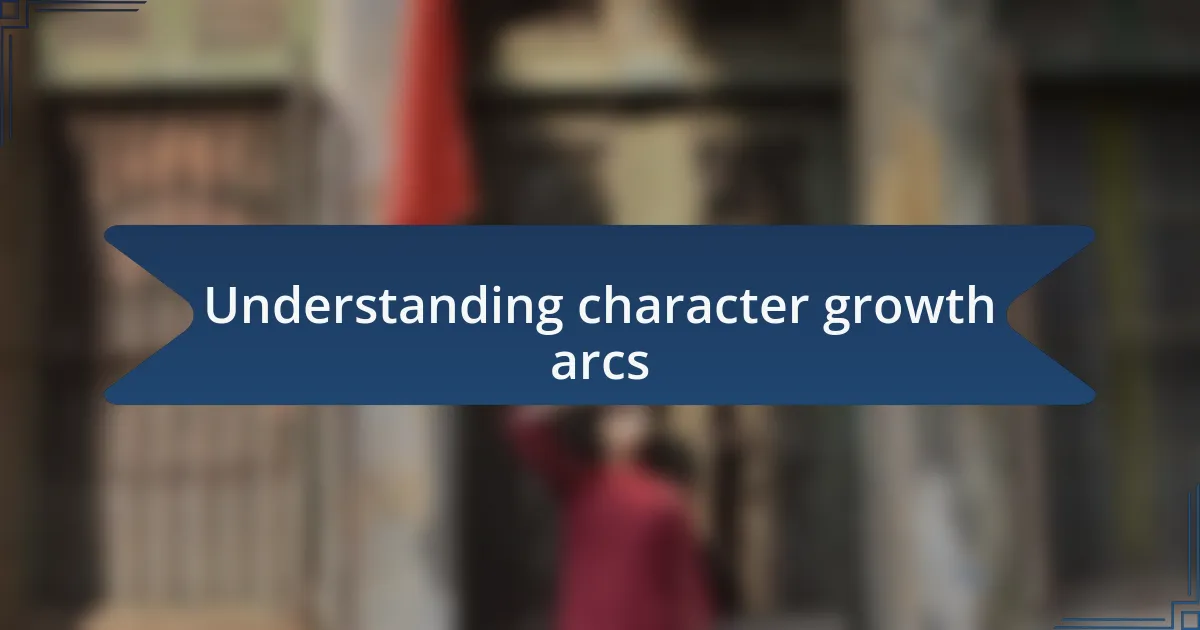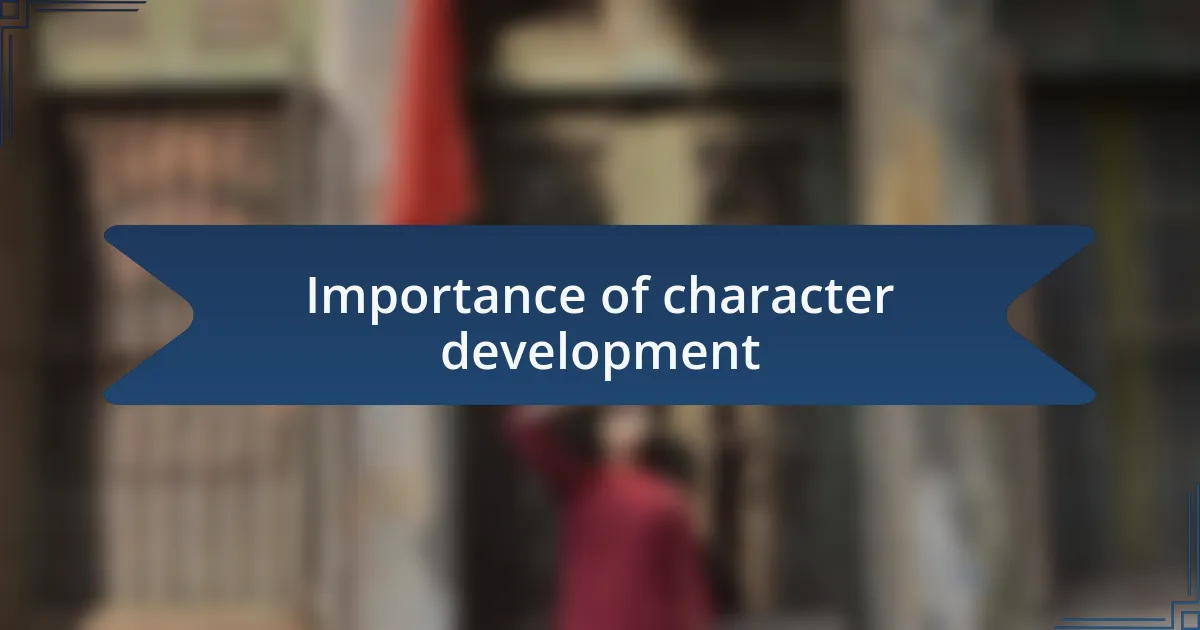Key takeaways:
- Character growth arcs illustrate the evolution of characters through experiences, emphasizing the journey rather than just the destination.
- Agatha Christie’s characters reflect complex human traits and moral dilemmas, inviting readers to explore their own values and relationships.
- The interplay of experience and transformation in Christie’s works underscores the significance of adversity in strengthening connections and personal growth.

Understanding character growth arcs
Character growth arcs are essential in storytelling as they illustrate how characters evolve through their experiences. For example, when I read “And Then There Were None,” I was struck by the transformation of each character, especially as the pressure of isolation revealed their true selves. This experience made me realize that growth is not always about the destination; it’s often shaped by the journey and the challenges faced along the way.
Think about your favorite fictional character—what was their pivotal moment? In my experience, these moments often clarify the character’s values and beliefs, leaving a lasting impact. They provoke questions within us, such as, “How would I react in a similar situation?” These reflections not only deepen our connection to the story but also expand our understanding of character arcs.
Moreover, the emotional resonance of a character’s growth can be deeply personal. In Agatha Christie’s novels, many characters grapple with guilt or redemption, mirroring our own struggles. I remember feeling a surge of empathy for those who sought forgiveness, as their journeys echoed the complexities of our real-life relationships. This tug at the heartstrings serves as a reminder that character growth arcs can illuminate the shared human experience, inviting us all to reflect on our paths.

Importance of character development
Character development is crucial because it makes stories relatable and engaging. When I reflect on Poirot’s journey across Christie’s novels, I can’t help but admire his meticulous nature but also the moments when he struggles with his own moral compass. This duality enriches the narrative; it shows that growth isn’t merely about solving puzzles—it’s also about understanding oneself in the broader human context. Isn’t it fascinating how a character’s flaws can mirror our own insecurities?
Additionally, through character development, authors create a deeper emotional connection with readers. I remember feeling genuinely invested in the character of Jane Marple as she navigated through the complexities of her small community. Each time she solved a crime, I felt a sense of triumph, as if I was part of her journey. This connection also sparks curiosity about our growth—how often do we overcome obstacles and reveal our true selves in the process?
Ultimately, well-crafted character arcs facilitate personal reflection. After finishing “Murder on the Orient Express,” I found myself pondering the moral dilemmas faced by the characters. I wondered, would I make the same choices they did if I were in their shoes? This kind of introspection makes character development not just a tool for storytelling, but a mirror reflecting our values and decisions, deepening our engagement with the narrative.

Agatha Christie’s influence on characters
Agatha Christie had an extraordinary ability to shape characters that resonate long after the final page is turned. Take Hercule Poirot, for instance; his obsession with order often leaves me curious about my own need for control in chaotic situations. Doesn’t it make you wonder why we sometimes cling to small things, like Poirot’s neatness, to find comfort amidst life’s unpredictability?
Then there’s Miss Marple, whose keen observation of human nature teaches us that understanding others helps us navigate our own lives. There have been times when I’ve found solace in her perceptive insights, especially in my own community struggles. I’ve asked myself, how often do we overlook the simple wisdom that lies in everyday interactions? Christie’s characters aren’t just fictional; they hold a mirror to our tendencies, shedding light on our relationships and behaviors.
Christie’s influence extends to her secondary characters as well, each imbued with their distinct growth arcs that reflect the complexities of humanity. I recall feeling a palpable sense of empathy for those less prominent figures, like the tormented souls in “The ABC Murders.” Their development often evoked questions about redemption and consequence. How often do we consider the journey of those who don’t take center stage? In my experience, these layers add depth to her narratives, encouraging us to examine the quieter stories in our own lives.
Key traits of Christie’s characters
Key traits of Christie’s characters
Christie’s characters often embody the complexities of human nature, displaying a mix of virtues and flaws that make them relatable. I remember the first time I encountered Poirot’s relentless pursuit of perfection—it struck a chord with my own struggles for excellence in my work. Have you ever felt torn between wanting to be the best and accepting your imperfections? This balance gives her characters a depth that lingers long after their stories end.
Another defining trait is their adaptability. Characters like Miss Marple exhibit a remarkable ability to evolve based on their experiences. It reminds me of the way I’ve had to adjust my perspective in challenging situations, learning to embrace change rather than fear it. When has a fresh viewpoint allowed you to overcome a personal hurdle? Christie masterfully illustrates this journey, inviting readers to find strength in their own transformations.
Moreover, Christie’s characters frequently grapple with moral dilemmas, which intensifies their development. I often find myself reflecting on the choices made by characters like the ambiguous figures in “And Then There Were None.” What drives someone to choose between right and wrong in high-stakes scenarios? These conflicts resonate deeply, prompting me to explore my values and the complexities of decision-making in my own life.
Analyzing growth in Christie’s works
Analyzing growth in Christie’s works reveals a fascinating interplay of experience and transformation. For instance, in “Murder on the Orient Express,” we see Poirot not just solving a murder but wrestling with his sense of justice in a world that’s often morally ambiguous. It’s intriguing to ask ourselves—how do our life experiences shape our understanding of right and wrong? Personally, I recall my own moments of ethical dilemma, where the path seemed less clear than I expected.
In examining characters like Tommy and Tuppence, it is evident that their relationship grows stronger through adversity. I remember how their resilience reminded me of my friendship with someone I faced challenges alongside. Has there been a time in your life where hardships have tested your bonds? Christie brilliantly showcases how such trials can lead to deeper connections and personal growth, reflecting the real-world dynamics of human relationships.
Furthermore, the profound shifts in her characters often mirror societal changes during her writing period. Just as I’ve adapted to the rapid changes in technology and culture, so too do Christie’s characters navigate evolving social landscapes. It’s fascinating to consider—how do we reconcile our identities with the world around us? Through her work, Christie encourages us to explore our own growth, making her narratives timeless and deeply relevant.

Personal reflections on growth arcs
Reflecting on growth arcs, I often find myself drawn to the subtle but significant changes characters undergo. In “And Then There Were None,” each character’s transformation reveals hidden depths and vulnerabilities, prompting me to think about my own growth. Have you experienced a moment where a challenge illuminated a previously unseen part of yourself? For me, facing my fears during a pivotal life decision led to a surprising revelation of strength I hadn’t known I possessed.
I also appreciate how Christie’s characters evolve through introspection and external influences. Take Miss Marple, for instance; her keen observations remind me of how we adapt our perspectives over time. I recall a time when I re-evaluated my approach to friendships after a misunderstanding taught me about empathy and listening. Isn’t it interesting how a single event can catalyze profound change in our relationships?
Moreover, I can’t help but relate to the way Christie’s narratives encapsulate the ebb and flow of personal growth amidst various circumstances. In my own life, I’ve experienced the push and pull of ambition and contentment, much like Poirot grappling with his purpose in a chaotic world. How do we balance our aspirations with the reality of our circumstances? Embracing this tension can be uncomfortable, but it’s often where the richest growth occurs.